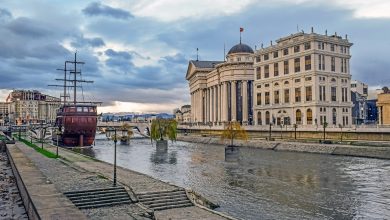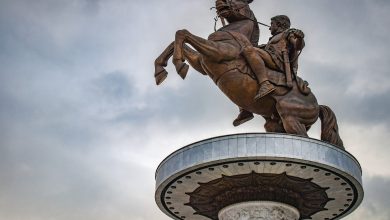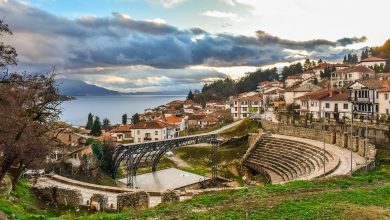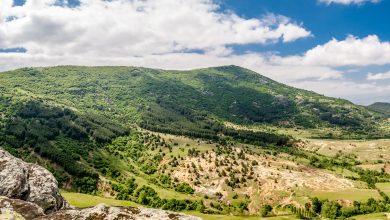Ancient cities of North Macedonia – places where empires and conquerors collided

The area of North Macedonia was populated several thousand years BC, and numerous peoples have passed through its territory since then. The Slovenian population immigrated in the 6th century AD and fought for a long time to survive and stay in this territory. Due to the multi-millennium tradition of different cultures, North Macedonia abounds with localities that preserve the memory of all those who have influenced it. Ancient fortresses and their remains can be found all over the country. Whether you are passing through this country on your way to Greece or traveling as a tourist, don’t miss the opportunity to visit some of the historically important places.
The Skopje Fortress – the place of the coronation of Tsar Dušan
On the Gradište hill above the Vardar River is the fortress known as The Skopje Fortress, the most important landmark of the Macedonian capital. It is located near the center of Skopje, so the fortress offers a wonderful view of the city. It is believed that the first fortress was built in the 6th century. It was built from large stone blocks taken probably from the nearby town of Skupi, which was destroyed in an earthquake in 518.
During its history, the fortress underwent several reconstructions – during the reign of Emperor Justinian I and later in the 10th and 11th centuries. There is no information about the fortress during the Middle Ages, but it is known that Tsar Dušan was crowned here. Due to its good strategic position, The Skopje Fortress was the target of numerous conquests and destructions, and during the period of Turkish attacks there was the most reconstruction and partitioning. The last major damage occurred during the earthquake in 1963. Despite various works, the fortress has maintained its stable shape to this day, and the towers have been restored.
Samuel’s fortress – a witness of centuries of conquests
Samuel’s Fortress is a medieval fortress on the coast of Lake Ohrid, located on two hills. The city is surrounded on three sides by ramparts of different heights. It was named after Tsar Samuel, who is credited with building the fortress in its present form. The name Ohrid fortress is also often used. After the collapse of Samuel’s empire, the city was conquered by the Byzantine Tsar Vasilije II in 1018. Throughout history, the fortress was also in the possession of Bulgarians and Normans, but Tsar Dušan occupied it in 1334, and it remained part of the Serbian state until the death of Marko Kraljević. Today, 18 towers and 4 gates have been preserved. A large number of silver carts, sandals, two gold masks and a bracelet with a ring were found at this region.

Towers of Marko Kraljević
Mark’s Town or Mark’s Towers are a medieval fortress above Prilep. It is located on a stone rise above today’s town. This region has been declared a natural asset of North Macedonia due to its specificity.
The first fort on the territory of the former town was most likely built by the Byzantines in the 10th century, and occasionally it was part of the First Bulgarian Empire. After the fall and rise of The Kometopuli dynasty, the fortress was part of the Macedonian or Samuel’s empire. The later fate of the town is also diverse – it was part of the Byzantium, The Despotate of Bulgaria and Epirus, and in the 13th century it was conquered by King Milutin. Pirlapon is the Byzantine name for the town from which today’s name Prilep originated. The so-called Prilep town was one of the capitals of the Empire during the reign of Dušan the Mighty, and later during the reign of King Marko from the Mrnjavčević dynasty, popularly known as Kraljević Marko. The fortress got its name from the name of this Serbian ruler. It consisted of several stone ramparts with towers, a keep and a palace. Today it is mostly in ruins since it was completely abandoned and left to decay after the Ottoman conquests.
Kitino Fortress – traces of the Bronze and Iron Age
Kitino Fortress is a fortress near Kičevo, it is located on a high hill where there are still remains of the foundations of the walls and towers. This place has existed since the Bronze and Iron Ages. Information about the existence of Kicevo was obtained from the Byzantine Tsar Vasilije II. At that time, the town was an important administrative and military center of Samuel’s Empire. Serbian king Stefan Uroš II also lived here. It is supposed that the fortress once consisted three walls and several towers. The memorial tomb has been preserved to this day, although much of it was destroyed. Once upon a time, there was a palace on the place of this tomb. In one of the towers, coins from the reign of Alexander the Great were found. Some remains of the fortress have been preserved and are located deep underground. Today, this area is an archaeological site, with a park and adapted for recreation and socializing.
Kokino – a 4.000-year-old observatory
Since the dawn of time, people have observed the world around them and been mesmerized by the nature that surrounds them. Among other things, interest in celestial bodies has always been the greatest. To support this, the existence of megalithic observatories in different parts of the world, created thousands of years ago, speaks for itself. The fourth such observatory is located in the north of today’s North Macedonia, about thirty kilometers from Kumanovo. It is known under the name Kokino and is more than 3800 years old. It was discovered by archaeologist Jovica Stankovski in 2001. It is located on top of Tatić Kamen at 1030 meters above sea level. In this place, the prehistoric residents followed the movement and cycles of the Sun and the Moon and performed various rituals. It is supposed that the observatory was created on a volcanic hill, the rocks of which were formed by the solidification of lava that poured out of the volcanic crater. The cracks created over time were the main indicator for marking the rising of the Sun and the Moon.
According to NASA, Kokino is the fourth megalithic observatory in the world, right after Abu Simbel in Egypt, Stonehenge in Great Britain and Angkor Wat in Cambodia.

Stobi – the cradle of Christianity
One of the most famous archaeological sites in North Macedonia is Stobi. The first pereserved memories of Stobi date back to 197 BC, when King Philip V defeated the Dardanian army at this place. It is located at the estuary of the Black River in Vardar, about 65 kilometers from Skopje, on the main road that leads from the Danube to the Aegean Sea. Due to this position, Stobi was one of the most important strategic and trading centers during the ancient period. It has been known under this name since the 4th century BC and originally belonged to Paionia. Evidence for the development of Christianity in Stobi dates back to 325. At that time, Stobi was the episcopal center and a town with a unique Christian religion in the then kingdom. Later, at the transition from the 5th to the 6th century AD, Stobi became the center of the province of Macedonia Secunda. According to Procopius, Stobi was destroyed in 518 from a strong earthquake. Four early Christian basilicas, the remains of seven palaces and eighteen floor mosaics were found on this site. Also, the remains of buildings dating from the 4th to the 6th century were discovered.
Tetovsko Fortress – heritage of Turkish pashas
At the foot of Šar mountain in the immediate proximity of Tetovo is the Tetovsko Fortress. It was built around 1820. According to legend, the construction was started by Redzip-pasha, and continued and completed by his son Abdurahman-pasha. The fortress was built of limestone and carved stone. Today’s resort consists of walls surrounding warehouses, a large kitchen, a well and other facilities. There were towers on the walls, and today there are also the remains of an underground prison and three tunnels, which lead from the fortress to Tetovo. One of the older buildings is also the church of St. Anastasia from the 14th century.
Heraclea Lyncestis – a legend of the ancient period
Heraclea Lyncestis is an ancient town located in the southern part of Bitola. It was named after Heracles, the mythical hero of the Macedonian Agreadi dynasty. It was founded in the pre-Roman period, around the 4th century BC, as it is supposed, during the reign of the Macedonian king Philip II. Heraclea was an important strategic center, but also major trade and traffic center on the so-called Via Egnatia, the road that connected Durrës and the Bosphorus. After the Macedonians, it was taken over by the Romans, and in the period from the 1st to the 4th century AD, it experienced its greatest rise. In the 6th century, the city was attacked by Avars and Slavs, so it soon fell into disrepair and was left without a population. The episcopal residence, the small and large basilica, the Roman bath, the theater and Justinian’s city fountain were discovered here. The best preserved are the mosaics and the theater, and archaeological excavations and reconstruction are still ongoing.
Treasure of Tsar’s Towers
The oldest discoveries about the fortress that rises on the hill above Strumica speak about life even before the Roman Empire, from the prehistoric period to the Middle Ages. According to some archaeologists, it could be the remains of the ancient city of Astraion. The fortress was built on a flat plateau on top of a hill that rises above Strumica at an altitude of 445 meters, from where it is possible to see the entire Strumica Valley. According to some data, construction began around the 4th century BC, and was only completed in the twelfth century. The first written sources about Strumica and the fortress date from the year 181. In the immediate proximity, five large pits were discovered, in which numerous spears, gold earrings, ceramics from the period of the Roman Empire were found. Also, during excavations on the hill near the fortress, rings, royal artifacts, a coin from the 4th century BC, as well as a large number of Byzantine and Venetian coins were found.
Author: Jana Stošić
Photographs: Pixabay



